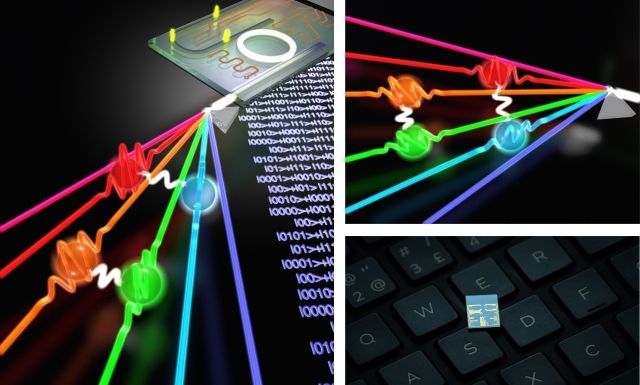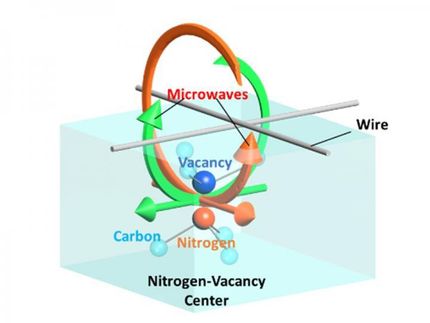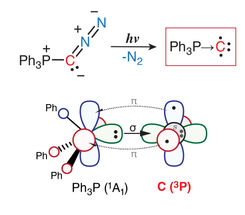Taking a giant step forward in generating optical qubits
The optical chip developed at INRS by Prof. Roberto Morandotti's team overcomes a number of obstacles in the development of quantum computers, which are expected to revolutionize information processing. The international research team has demonstrated that on-chip quantum frequency combs can be used to simultaneously generate multiphoton entangled quantum bit (qubit) states.

In a recently published article in Science, Prof. Roberto Morandotti and his team demonstrate the generation of complex entangled quantum states on an optical chip, bringing us one step closer to practical applications in quantum information processing. Left: On-chip frequency combs for scalable, complex quantum state generation. Top right: Quantum frequency comb of entangled photons. Bottom right: Photonic chip – compatible with common semiconductor fabrication technologies.
Ultrafast Optical Processing Group, 2016
Quantum computing differs fundamentally from classical computing, in that it is based on the generation and processing of qubits. Unlike classical bits, which can have a state of either 1 or 0, qubits allow a superposition of the 1 and 0 states (both simultaneously). Strikingly, multiple qubits can be linked in so-called 'entangled' states, where the manipulation of a single qubit changes the entire system, even if individual qubits are physically distant. This property is the basis for quantum information processing, aiming towards building superfast quantum computers and transferring information in a completely secure way.
Professor Morandotti has focused his research efforts on the realization of quantum components compatible with established technologies. The chip developed by his team was designed to meet numerous criteria for its direct use: it is compact, inexpensive to make, compatible with electronic circuits, and uses standard telecommunication frequencies. It is also scalable, an essential characteristic if it is to serve as a basis for practical systems. But the biggest technological challenge is the generation of multiple, stable, and controllable entangled qubit states.
The generation of qubits can rely on several different approaches, including electron spins, atomic energy levels, and photon quantum states. Photons have the advantage of preserving entanglement over long distances and time periods. But generating entangled photon states in a compact and scalable way is difficult. "What is most important, several such states have to be generated simultaneously if we are to arrive at practical applications," added INRS research associate Dr. Michael Kues.
Roberto Morandotti's team tackled this challenge by using on-chip optical frequency combs for the first time to generate multiple entangled qubit states of light. As Michael Kues explains, optical frequency combs are light sources comprised of many equally-spaced frequency modes. "Frequency combs are extraordinarily precise sources and have already revolutionized metrology and sensing, as well as earning their discoverers the 2005 Nobel Prize in Physics."
Thanks to these integrated quantum frequency combs, the chip developed by INRS is able to generate entangled multi-photon qubit states over several hundred frequency modes. It is the first time anyone has demonstrated the simultaneous generation of qubit multi-photon and two-photon entangled states: Until now, integrated systems developed by other research teams had only succeeded in generating individual two-photon entangled states on a chip.
The results will provide a foundation for new research, both in integrated quantum photonics and quantum frequency combs. This could revolutionize optical quantum technologies, while at the same time maintaining compatibility with existing semiconductor chip technology.
Original publication
Reimer, Christian and Kues, Michael and Roztocki, Piotr and Wetzel, Benjamin and Grazioso, Fabio and Little, Brent E. and Chu, Sai T. and Johnston, Tudor and Bromberg, Yaron and Caspani, Lucia and Moss, David J. and Morandotti, Roberto; "Generation of multiphoton entangled quantum states by means of integrated frequency combs"; Science; 2016




















































